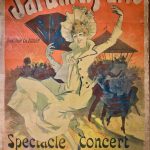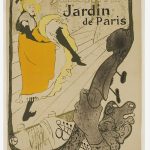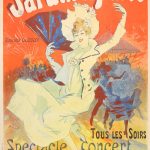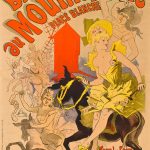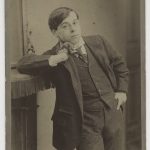The Jardin de Paris was a café-concert hall owned by the proprietor of the Moulin Rouge. Below are some examples of posters from the Jardin de Paris including a Fete de Nuit Bal by Jules Cheret and Jane Avril by Henri de Toulouse-Lautrec.
Jardin de Paris – Fete de nuit Bal, 1890. French Art Nouveau lithograph theater poster in colors JARDIN DE PARIS by Jules Cheret. Jules Cheret (French, 1836-1932). Linen backed. Printed signature lower left. Printed by Chaix, Paris. Catalogue raisonne, Broido 251. Dimensions: H: 48 1/4 in (122.5 cm), W: 33 1/2 in. (85 cm). *Please note on each corner we placed a coin to hold the poster in place…thus the circular dark corners. Condition: linen backed, overall good condition. consistent with age (view all photos for accuracy).
Sold for $325 at Kensington Estate Auction in 2020
Jane Avril au Jardin de Paris
A woman in a red dress and feathered hat raises her leg in the can-can while dancing on stage. In the foreground a musician playing a double-bass can be seen in the orchestra pit.
Toulouse-Lautrec, Henri de, born 1864 – died 1901 (artist)
Reference: © Victoria and Albert Museum
JULES CHÉRET (1836-1932) Jardin de Paris – Fête de nuit bal (B. 250), 1890 Lithograph in colors, on wove paper, backed with linen, printed by Chaix, Paris, the full sheet. sheet 48 7/8 x 33 3/8in (124.1 x 84.7cm)
Sold for US$ 1,530 (£ 1,239) inc. premium at Bonham’s in 2019
The Belle Époque was a period of peace and optimism marked by industrial progress, and a particularly rich cultural exuberance was about at the opening of the Moulin Rouge. The Expositions Universelles of 1889 and 1900 are symbols of this period. The Eiffel Tower was also constructed in 1889, epitomising the spirit of progress along with the culturally transgressive cabaret. Japonism, an artistic movement inspired by the Orient, with Henri de Toulouse-Lautrec as its most brilliant disciple, was also at its height. Montmartre, which, at the heart of an increasingly vast and impersonal Paris, retained a bucolic village atmosphere; festivities and artists mixed, with pleasure and beauty as their values. On 6 October 1889, the Moulin Rouge opened in the Jardin de Paris, at the foot of the Montmartre hill. Its creator Joseph Oller and his Manager Charles Zidler were formidable businessmen who understood the public’s tastes. The aim was to allow the very rich to come and ‘slum it’ in a fashionable district, Montmartre. The extravagant setting – the garden was adorned with a gigantic elephant – allowed people from all walks of life to mix. Workers, residents of the Place Blanche, artists, the middle classes, businessmen, elegant women, and foreigners passing through Paris rubbed shoulders. Nicknamed “The First Palace of Women” by Oller and Zidler, the cabaret quickly became a great success. Reference: Wikipedia
